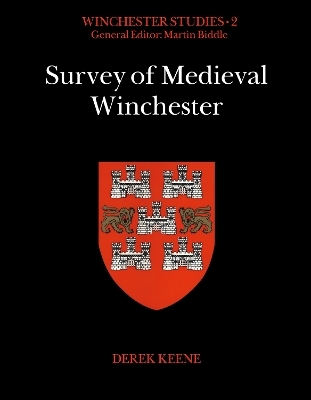
Survey of Medieval Winchester
Seiten
2024
Archaeopress Archaeology
978-1-80327-018-0 (ISBN)
Archaeopress Archaeology
978-1-80327-018-0 (ISBN)
- Noch nicht erschienen (ca. Dezember 2024)
- Versandkostenfrei innerhalb Deutschlands
- Auch auf Rechnung
- Verfügbarkeit in der Filiale vor Ort prüfen
- Artikel merken
This survey is based on a reconstruction of the histories of the houses, plots, gardens, and fields in the city and suburbs of Winchester between c. 1300 and c. 1540. The reconstruction presents a gazetteer of 1,128 histories of properties, with accounts of 56 parish churches and the international fair of St Giles, all illustrated by detailed maps.
By the fourteenth century Winchester had lost its former eminence, but in trades, manufactures, and population, as well as by virtue of its administrative and ecclesiastical role, the city was still one of the major provincial centres in England. This Survey is based on a reconstruction of the histories of the houses, plots, gardens, and fields in the city and suburbs between c. 1300 and c. 1540, although in many instances both earlier and later periods are also covered. The reconstruction takes the form of a gazetteer (Part ii) of 1,128 histories of properties, together with accounts of 56 parish churches and the international fair of St. Giles, all illustrated by detailed maps. There is also a biographical register (Part iii) concerning more than 8,000 property-holders, most of whom lived in Winchester. This is the first time that it has been possible to piece together such a precise and detailed picture of both the topography and the inhabitants of a medieval town. Part i of the book contains a full discussion of the significance of this material and, in a manner relevant to an understanding of life in medieval towns in general, describes and defines such matters as the evolution of the physical environment, housing, land-tenure, property values, the parochial structure, the practice and organization of trades, and the ways in which the citizens of Winchester adapted to the declining status of their city.
By the fourteenth century Winchester had lost its former eminence, but in trades, manufactures, and population, as well as by virtue of its administrative and ecclesiastical role, the city was still one of the major provincial centres in England. This Survey is based on a reconstruction of the histories of the houses, plots, gardens, and fields in the city and suburbs between c. 1300 and c. 1540, although in many instances both earlier and later periods are also covered. The reconstruction takes the form of a gazetteer (Part ii) of 1,128 histories of properties, together with accounts of 56 parish churches and the international fair of St. Giles, all illustrated by detailed maps. There is also a biographical register (Part iii) concerning more than 8,000 property-holders, most of whom lived in Winchester. This is the first time that it has been possible to piece together such a precise and detailed picture of both the topography and the inhabitants of a medieval town. Part i of the book contains a full discussion of the significance of this material and, in a manner relevant to an understanding of life in medieval towns in general, describes and defines such matters as the evolution of the physical environment, housing, land-tenure, property values, the parochial structure, the practice and organization of trades, and the ways in which the citizens of Winchester adapted to the declining status of their city.
| Erscheint lt. Verlag | 31.12.2024 |
|---|---|
| Reihe/Serie | Winchester Studies |
| Verlagsort | Oxford |
| Sprache | englisch |
| Maße | 215 x 276 mm |
| Gewicht | 600 g |
| Themenwelt | Geisteswissenschaften ► Archäologie |
| Geschichte ► Allgemeine Geschichte ► Mittelalter | |
| ISBN-10 | 1-80327-018-7 / 1803270187 |
| ISBN-13 | 978-1-80327-018-0 / 9781803270180 |
| Zustand | Neuware |
| Haben Sie eine Frage zum Produkt? |
Mehr entdecken
aus dem Bereich
aus dem Bereich
Stammbaum der nordischen Götter nach der Edda von Snorri Sturluson …
Poster (2020)
Schulze Media
19,90 €

